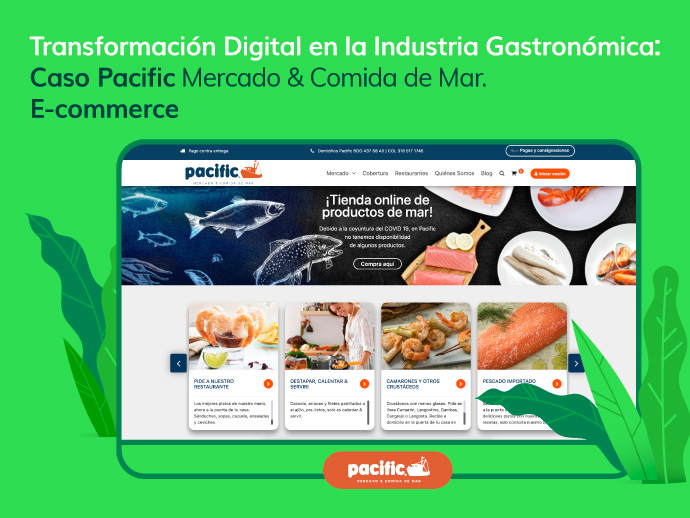
Pacific Mercado & Comida de Mar, is a fishmonger passionate about gastronomy with more than 22 years of experience in the selection and logistics of a responsible fishing chain, it has a wide variety of products: imported salmon, shrimp, prawns, Colombian fish (trout, tilapia, and mojarra), mollusks, mussels, among others. All its products are obtained under sustainable practices that contribute to changing the fishing and consumption conditions in the Colombian market.
Another business vertical for the company is its own chain of restaurants, which stand out for their high-quality fresh products from some regions of the country and other parts of the world. Pacific’s restaurants are a space for exalting the flavors of the sea, with the own recipes of its different chefs. They offer a wide variety of options to the delight of seafood lovers, including sandwiches, soups, salads, ceviche, cocktails, etc. You can see their offices here.
Read the rating and opinion of Karl Herbel, CEO of Pacific: Here
Their experience has led them to be positioned in the B2B (business to business) market with the best restaurants and hotels in the city. They are suppliers of Wok, Crepes & Waffles, and Cine Colombia, among others. With the search to enter to develop a new sales channel, they potentiate their business digital transformation process. The objective was to digitally open the entire B2C (business to consumer) market, be a leader in the digital industry and enter the home of Colombians.
The great challenge for Tuatara | Boutique Agency and Pacific was to improve the brand’s digital presence by creating a digital sales channel so that it is B2C and B2B buyer persona had an excellent shopping experience (UX). This digital marketing strategy was carried out under agile and validated learning methodologies such as Lean Startup + Inbound Marketing + Growth Hacking.
Know your audience and send the right message…
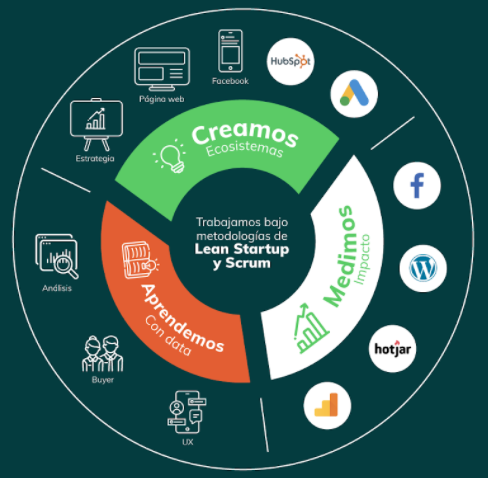
Main goal
Create a sustainable digital ecosystem that was a new, profitable, and scalable sales channel. This will be carried out by doing work from branding, developing e-commerce, and nurturing users through automation, content, and guidelines processes.
Secondary objectives
- Develop the website under user experience (UX), user interface (UI), SEO, and performance practices.
- Claim Google places and link them to the brand, improving your reputation. (zmot)
- Generate quality leads for the purchase of seafood. (Inbound marketing)
- Plan, design, and automate communication flows through email. (Inbound marketing)
- Planned, write, and design digital content grids for social networks. (Growth marketing)
- Plan, build, and optimize advertising campaigns in different media. (Growth marketing)
- Administer, segment, manage and characterize leads from the acquired database.
- Manage, analyze, and activate all the data that digital media throws up. (Growth marketing)
- Teach and educate the company about new digital strategies. (The digital transformation of companies is done from within).
- Review and integrate new software into the digital ecosystem.
“Their skills stood out, as did their ability to adapt their knowledge to the local market. They got involved in our business, taking the time to get to know the company. This provided them with great expertise about our product.” Karl Herbe CEO Pacific.
Digital markets across all industries are at different stages; In this case, the cake started small, digitally speaking (the sale of frozen fish online). Not because it didn’t exist, but simply because the customs and bidders could improve the UX for their customers. And although being a nascent industry, there was a blue ocean of opportunities, paradigm shifts, and education towards shopping habits, it does not happen overnight. In this sense, the path of the defined buyer was aimed at building a brand acceptance and trust strategy to be able to start Inbound Marketing flows, which would meet the expectations of future customers, generate an intention for the purchase and educate them. of an industry. This is how we started with all the business digital transformation work at Tuatara.
Start of business digital transformation process | Pacific
Unlike traditional marketing, audience segmentation can be done much more effectively in digital marketing, through specific filters of interests and behaviors and hypothesizing new segments that may be interested in your value proposition. It. Important before doing, know who we are going to talk to, for this the first thing is to recognize your Buyer Persona.
This exercise allows you to always keep in mind and visualize more broadly the type of client who is interested in your message. This degree of empathy that is generated with the audience makes a noticeable difference in positive results in the medium and long term.
Buyer Persona Planning – B2C (illustrative example)
Planeación Buyer Persona – B2C (ej. ilustrativo)

Mariana: she is an enterprising woman, a lover of cooking and seafood, and she likes to make dishes for her family and friends. “You don’t always get the best quality or variety of products in the supermarket.” She likes to constantly learn about the category and looks for ways to surprise her guests with new recipes.
Hypothesis to validate
- The Buyer persona has the price as a decisive factor at the moment of purchase.
- The Buyer persona has reputation and trusts as decisive factor at the time of purchase.
- The Buyer person seeks a lot of information regarding seafood.
- The Buyer persona wants to know what they can do with our product.
Continue reading: Digital Transformation in the Automotive Industry: Renault Alianza Motor Case
Buyer persona planning – B2B (illustrative example)
Planeación Buyer persona – B2B (ejm. ilustrativo)

Camilo: he is the owner and chef of his Sushi restaurant. He cares about the raw material he gets for his diners, as he is convinced that to grow, he needs to have a positive word of mouth. Almost every day he goes to the market to buy the best products, this represents resources for him. You are increasingly aware of your responsibility to the planet when choosing the right type of provider.
Hypothesis to validate
- The price is a decisive factor at the time of purchase.
- The supplier’s reputation is decisive at the time of purchase.
- The contact and after-sales service encourages the first approach.
Brand diagnosis (Branding) Pacific
According to the identity manual, the Pacific logo had 12 versions, which made it confusing and difficult to position. We start the consulting process with the adjustment of the brand (Everything is communicated from the brand/branding). The simplification of the logo is an extremely necessary and useful resource for the versatility of the brand in digital ecosystems.
As an immediate action, the suggestion was made to simplify it, improve readability a bit, and build everything with a brand that begins the positioning work.
All brands must have a horizontal version (existing) and a vertical version (proposed) for proper use in different spaces depending on their size and legibility.
Read Brand building (Branding) From Sketch to Digital “everything starts from the paper” – by Charlz here
Pacific e-commerce diagnosis
Pacific’s e-commerce presented several opportunities for improvement. It did not meet the objectives of UX (user experience) or Marketing, harming its performance, usability, and sales. Also, there was no clear measurement of the functions that it fulfilled, therefore it was very ambiguous to make decisions that were in favor of improving the results.
The performance and loading times (performance) of the website and the SEO practices applied at the time, did not allow organic growth and positioning in the gastronomic sector. We also had to urgently work on ZMOT strategies and the online reputation of the brand. Users were managing their PQR through digital channels, however, the response processes were not clear, giving a bad perception.
“Every digital user generates a purchase intention in an e-commerce after it has already generated trust”
How do we improve the experience on the website while positioning it in search engines?
It is not enough to have just one web page to drive traffic and generate conversions, beyond that, we identify that users when browsing the Internet look for relevant and attractive content to choose the best option. Thus, under this premise, a whole process elaborated from development, design, and marketing was developed.
- Optimized resources to reduce loading times.
- We structure the HTML code with rich data (Meta tags) based on Schema.org
- The responsive and custom design allows the correct deployment of the website on different devices.
- HTML structure optimized for search engines.
- Integration with marketing automation platforms, Analytics and Search Console.
- Sending abandoned cart emails to encourage purchases, through a plugin integrated into the administrator. Multiple payment options (PayU) such as credit card, ballot, PSE, etc. Optimized friendly URLs.
- Security certificate to encrypt sensitive data within the website (such as payment transactions, etc.).
What tools do we use to measure e-commerce?
Qué herramientas usamos para la medición de un e-commerce?

Hotjar: is an online tool that provides information about visitor interactions on your pages. This is how we managed to obtain valuable information from the digital asset such as user clicks and scroll down. This information helped us to adjust the design of the page.
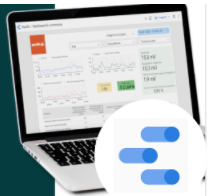
Google Data Studio: To connect all the digital assets and measurement tools in real-time of the data. We use Google Data Studio, it is a very efficient tool that allows us to analyze the data visually, making it easier and more immediate to obtain results.
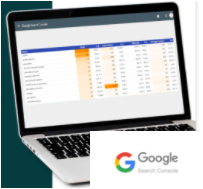
Google Search Console: Thanks to this platform, it allows us to improve search results, making continuous monitoring of the keywords that have the best performance and those that can improve. With this, we check the indexing status of your sites on the internet by the search engine and optimize their visibility.
Pacific – SEO strategy for e-commerce positioning
The contents made in Blogpost format are the value content created to achieve the desired organic positioning. For this, a joint effort was made between engineering and marketing to ensure that search engines like Google could better track, index, and understand our content.
We linked the Google Search Console tool to have a measurement in positioning from day one. This manages to measure all the related keywords (keywords) to the category of brand products, we set ourselves the objective of positioning keywords that go hand in hand with the following verticals:
- Broad Keywords
- Keywords content
- Keywords Branding
- Keywords by category
Measurement Indicators
- Keywords
- Backlinks and Lin binks
- CTR
- Conversion rate
- Permanence
- bounce rate
- charging speed
- traffic per device
- Without content, there is no SEO ranking on Google
Diagnosis of social networks of the Pacific brand
Pacific’s social networks were a bit monothematic and a basic communication strategy was lacking. The engagement of its contents was very low, communication was not being generated from the brand (branding) and the graphic line was not in accordance with the principles and values that the company wanted to represent. Likewise, there was no efficient SAC (customer service) and many potential clients were left without an answer.
Social media strategy for an e-commerce
Main objective: Know the main tastes of the audience and optimize advertising campaigns from the generation of organic content. Create – Measure – Learn, about copies, graphic lines, and captions, among other variables.
A. Create static parts.
B. Create short videos.
C. Create carousels.
D. Develop marketing copy, not literature.
E. Create content that supports the hypotheses.
F. Create 360.
G. Use Stories for different social networks.
Both the promoted post pieces and the organic pieces retain a similar art that makes them easily distinguishable from the rest of the pieces on the market. This begins to generate a brand positioning (branding) that leads to a purchase when the Buyer Persona presents an intent. The use of the brand’s colors and the use of superior quality images managed to be attractive content to be fixed in the memory of those who were being impacted by the communication.
Inbound Marketing: Fall in love with your customers through marketing automation
Inbound marketing strategies were implemented to nurture and lead leads until the moment of purchase, it was created under the 4 stages of the funnel that makes up the buyer’s path, which are: learning and discovery, problem recognition, consideration of the solution, and purchase decision. Through automation flows within the RD Station platform, we began to generate the necessary trust so that the leads we captured in the stages before the purchase felt calm when they generated a need. This strategy represents between 25% and 30% of monthly e-commerce sales.
Lead Capture: Instagram, Facebook, Adwords, WordPress, WhatsApp, Landing, SAC, SEO.
Lead treatment: RD Station, automation, Email marketing, lead nurturing.
Marketing + Sales Force: Rigorous monitoring of leads acquired by vertical.
Every user who comes into contact with the brand initiates a communication of more than 8 months in which we link the impacts by mail with other strategies that may be relevant to users: eBooks, blog posts, recipes, webinars, etc. For each of these tactics, we propose some hypotheses to recognize what attracts the most attention and redirect future e-commerce efforts toward this solution.
Validated hypotheses and generated learning
To carry out a Digital Marketing strategy, understanding the path of the buyer, an iterative process must be applied, that is, a process that is permanently fed and updated based on the results obtained. In this way, we were able to establish the following hypotheses to validate verify, and provide feedback based on the data collected.
- What Inbound content generates more value for the Buyer Persona?
- What is the sales channel that best generates ROI?
- Should our average ticket be greater than $70,000?
- Should the organic channel convert significantly after one year?
- Which emails generate better direct sales?
- Should our guidelines on facebook be directed to the product?
In order to have an answer to each of the questions, it is not enough to ask them. An iterative process must be entered into within the Measurement stage of the methodology.
Discoveries from guidelines for e-commerce
a. Ad campaigns focus on inbound content rather than the product.
b. The buyer’s path starts from topics of interest in the industry.
c. We identified the campaign objectives that brought the best traffic to e-commerce.
d. We found B2B and B2C pattern segments.
Results of the digital transformation process with Pacific
Pacific entered a blue ocean unexplored by most players in this industry a few years ago. This ventured us to build unique information for the brand, understand how its audience was made up, and retain users. The information and knowledge acquired are a competitive advantage over your competition, since there is clearer information on where to invest to grow in digital sales. The infinity of information provided by the data thanks to the digital measurement, tracking, and follow-up platforms, indicate the direction of the strategy and the findings for each proposed objective.
The sales channel has been built and strengthened with different types of strategies, sales have diversified into acquisition channels that do not cost in the guideline, and a growing community that loves the brand has been built to boost its growth. In a typical month, e-commerce usually has the following sales behavior:
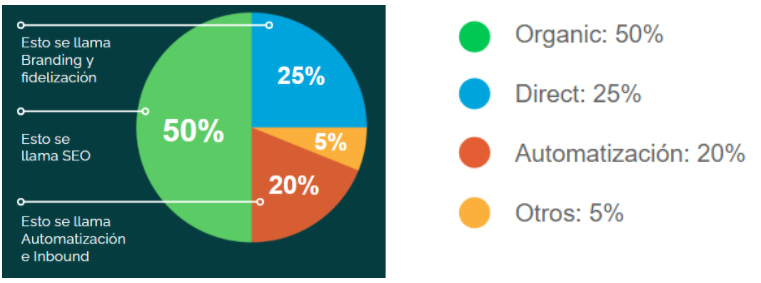
This e-commerce is a self-sustaining digital asset, it no longer depends on the guideline to achieve sales and continue growing (however, with the guideline the possibilities of future sales increase, snowball effect) the close analysis of the UX on the platform and the content is vital to continue growing.
The organic positioning of Pacific’s e-commerce was achieved thanks to the implemented SEO (Search Engine Optimization) strategies, Inbound Marketing, content strategies, guidelines, and a whole audience learning process that took months of work to get to the point current. Through keyword research and audience interest in industry content, we ensure search engine positioning by creating content that could not be found on Google such as “how to calculate the portions of fish and shellfish?”. “Recipes with salmon” among others.
These initial points of contact make people who at some point want to buy E-commerce products approach the brand through other types of interest, begin to build trust, and when they are ready to buy they have Pacific at their disposal. their main considerations.
Build a self-sustaining sales channel yourself, tell me your idea, and contact us here.